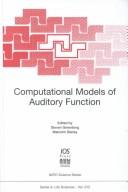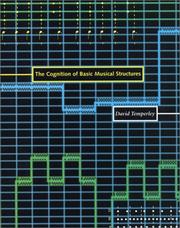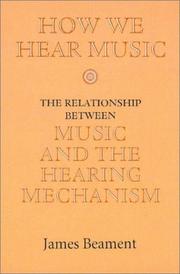| Listing 1 - 5 of 5 |
Sort by
|

ISBN: 9051994575 4274904652 Year: 2001 Volume: v. 312 Publisher: Amsterdam ; Berlin ; Oxford Brussels IOS Press NATO. Scientific Affairs Division
Abstract | Keywords | Export | Availability | Bookmark
 Loading...
Loading...Choose an application
- Reference Manager
- EndNote
- RefWorks (Direct export to RefWorks)
Auditory pathways --- Auditory perception --- Voies auditives --- Perception auditive --- Computer simulation --- Congresses --- Congresses. --- Programmation fonctionnelle --- Congrès --- Hearing --- Mathematical models --- Congrès --- HEARING TESTS --- COMPUTERS --- METHODS

ISBN: 9782747510035 2747510034 Year: 2001 Publisher: Paris : L'Harmattan,
Abstract | Keywords | Export | Availability | Bookmark
 Loading...
Loading...Choose an application
- Reference Manager
- EndNote
- RefWorks (Direct export to RefWorks)
Music --- Auditory perception --- Musique --- Sémiotique et musique --- Perception auditive --- Psychological aspects --- Congresses. --- Semiotics --- Congresses --- Aspect psychologique --- Congrès --- Sémiotique et musique --- Congrès
Book
ISBN: 0262284766 0585445222 9780262284769 9780585445229 Year: 2001 Publisher: Cambridge, Mass. : MIT Press,
Abstract | Keywords | Export | Availability | Bookmark
 Loading...
Loading...Choose an application
- Reference Manager
- EndNote
- RefWorks (Direct export to RefWorks)
In this book, David Temperley addresses a fundamental question about music cognition: how do we extract basic kinds of musical information, such as meter, phrase structure, counterpoint, pitch spelling, harmony, and key from music as we hear it? Taking a computational approach, Temperley develops models for generating these aspects of musical structure. The models he proposes are based on preference rules, which are criteria for evaluating a possible structural analysis of a piece of music. A preference rule system evaluates many possible interpretations and chooses the one that best satisfies the rules. After an introductory chapter, Temperley presents preference rule systems for generating six basic kinds of musical structure: meter, phrase structure, contrapuntal structure, harmony, and key, as well as pitch spelling (the labeling of pitch events with spellings such as A flat or G sharp). He suggests that preference rule systems not only show how musical structures are inferred, but also shed light on other aspects of music. He substantiates this claim with discussions of musical ambiguity, retrospective revision, expectation, and music outside the Western canon (rock and traditional African music). He proposes a framework for the description of musical styles based on preference rule systems and explores the relevance of preference rule systems to higher-level aspects of music, such as musical schemata, narrative and drama, and musical tension [Publisher description].
Music theory --- Musical perception --- Théorie musicale --- Perception de la musique --- Music --- Music, Dance, Drama & Film --- Music Instruction & Study --- Auditory perception --- Musical theory --- Theory of music --- Data processing. --- Computer simulation. --- Informatique. --- Simulation par ordinateur. --- Data processing --- Computer simulation --- Psychological aspects --- Theory

ISBN: 0262201348 Year: 2001 Publisher: Cambridge (Massachusetts) MIT Press
Abstract | Keywords | Export | Availability | Bookmark
 Loading...
Loading...Choose an application
- Reference Manager
- EndNote
- RefWorks (Direct export to RefWorks)
In this book, David Temperley addresses a fundamental question about music cognition: how do we extract basic kinds of musical information, such as meter, phrase structure, counterpoint, pitch spelling, harmony, and key from music as we hear it? Taking a computational approach, Temperley develops models for generating these aspects of musical structure. The models he proposes are based on preference rules, which are criteria for evaluating a possible structural analysis of a piece of music. A preference rule system evaluates many possible interpretations and chooses the one that best satisfies the rules. After an introductory chapter, Temperley presents preference rule systems for generating six basic kinds of musical structure: meter, phrase structure, contrapuntal structure, harmony, and key, as well as pitch spelling (the labeling of pitch events with spellings such as A flat or G sharp). He suggests that preference rule systems not only show how musical structures are inferred, but also shed light on other aspects of music. He substantiates this claim with discussions of musical ambiguity, retrospective revision, expectation, and music outside the Western canon (rock and traditional African music). He proposes a framework for the description of musical styles based on preference rule systems and explores the relevance of preference rule systems to higher-level aspects of music, such as musical schemata, narrative and drama, and musical tension [Publisher description].
#PBIB:2003.2 --- muziektheorie --- Music --- dataprocessing --- computersimulaties --- Artificial intelligence. Robotics. Simulation. Graphics --- Affective and dynamic functions --- Music theory --- Musical perception --- Théorie musicale --- Perception musicale --- Theory --- Data processing --- Computer simulation --- Music theory - Data processing. --- Musical perception - Computer simulation. --- Musical theory --- Theory of music --- Auditory perception --- Psychological aspects

ISBN: 0851159400 0851158137 9786611949037 1281949035 1846154413 9780851159409 Year: 2001 Publisher: Rochester, NY : Boydell Press,
Abstract | Keywords | Export | Availability | Bookmark
 Loading...
Loading...Choose an application
- Reference Manager
- EndNote
- RefWorks (Direct export to RefWorks)
Choice Outstanding Academic Title (2002)Our hearing system chose the sounds for music. During the past fifty years there have been spectacular advances in our knowledge of how that system works and it seems possible that it might provide explanations for a range of musical phenomena. This book begins by discussing the early evolution of simple 'western' tonal music; what exactly were the characteristics of the intervals and scales which hearing selected. It then considers problems such as what hearing has selected as instrumental tone, and why we have such a peculiar assessment of loudness; why is that independent of pitch, and why is hearing so sensitive to time? Does the mechanism of hearing determine our pitch discrimination, which differs so much across our hearing range? Amongst other things, this discussion leads to the conclusion that the harmonics of musical sounds, which are the basis of so much theory about music, did not and cannot play the role which has been so widely attributed to them ever since the work of Helmholtz in 1870. There follows a simplified account of the hearing mechanism: how musical sound is coded by the ear, the nature of the processing stations through which the information passes before it creates sensation in the cortex, and the extent to which it provides answers to the questions which have been raised. This produces a rather different view of the basis of some fundamental features of music from those which are commonly held. It also leads to the conclusion that music started with primitive instruments rather than with the human voice. Finally, the biological reasons for the hearing mechanism behaving as it does are explained, and thus the reasons for the sensations of music being experienced in the way they are. No scientific knowledge is assumed; any simple physical acoustics required is explained, and there are no mathematical equations. The late Professor Sir JAMES BEAMENT was a distinguished scientist and musician, who taught and examined music students at Cambridge University.
Acoustics --- Acoustique --- Akoestiek --- Audition (Physiology) --- Gehoor --- Hearing --- Music -- Perception --- Musical perception --- Musique -- Perception --- Muziek -- Perceptie --- Muzikale perceptie --- Muzikale waarneming --- Oreille absolue --- Oreille musicale --- Ouïe --- Perception de la musique --- Perception musicale --- Physiological acoustics --- Music --- Acoustics and physics --- Music - Acoustics and physics. --- Music - Acoustics and physics --- Music - Physiological aspects --- Musical perception. --- Hearing. --- Acoustics and physics. --- Ouïe --- Musique --- Acoustique et physique --- 515 --- 840 --- Musical acoustics --- Physics --- Sound --- Monochord --- Auditory perception --- Bioacoustics --- Senses and sensation --- Audiology --- Auditory pathways --- Deafness --- Ear --- Listening --- Akoestika --- Muziekgeschiedenis: essays (histor. onderwerpen, literaire analyses) --- Psychological aspects --- 78.82 --- Acoustics. --- Hearing Mechanism. --- Music. --- Sound Direction. --- Western Music.
| Listing 1 - 5 of 5 |
Sort by
|

 Search
Search Feedback
Feedback About
About Help
Help News
News